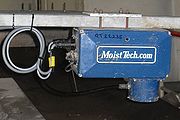
Moisture
Encyclopedia

Liquid
Liquid is one of the three classical states of matter . Like a gas, a liquid is able to flow and take the shape of a container. Some liquids resist compression, while others can be compressed. Unlike a gas, a liquid does not disperse to fill every space of a container, and maintains a fairly...
, especially water
Water
Water is a chemical substance with the chemical formula H2O. A water molecule contains one oxygen and two hydrogen atoms connected by covalent bonds. Water is a liquid at ambient conditions, but it often co-exists on Earth with its solid state, ice, and gaseous state . Water also exists in a...
, often in trace amounts. Small amounts of water may be found, for example, in the air (humidity
Humidity
Humidity is a term for the amount of water vapor in the air, and can refer to any one of several measurements of humidity. Formally, humid air is not "moist air" but a mixture of water vapor and other constituents of air, and humidity is defined in terms of the water content of this mixture,...
), in food
Food
Food is any substance consumed to provide nutritional support for the body. It is usually of plant or animal origin, and contains essential nutrients, such as carbohydrates, fats, proteins, vitamins, or minerals...
s, and in various commercial products
Product (business)
In general, the product is defined as a "thing produced by labor or effort" or the "result of an act or a process", and stems from the verb produce, from the Latin prōdūce ' lead or bring forth'. Since 1575, the word "product" has referred to anything produced...
.
Moisture control in products

Dry matter
The dry matter is a measurement of the mass of something when completely dried.The dry matter of plant and animal material would be its solids, i.e. all its constituents excluding water. The dry matter of food would include carbohydrates, fats, proteins, vitamins, minerals, and antioxidants...
. Ranging in products from cornflake cereals to washing powders
Laundry detergent
Laundry detergent, or washing powder, is a substance that is a type of detergent that is added for cleaning laundry. In common usage, "detergent" refers to mixtures of chemical compounds including alkylbenzenesulfonates, which are similar to soap but are less affected by "hard water." In most...
, moisture can play an important role in the final quality of the product. There are two main aspects of concern in moisture control in products: allowing too much moisture or too little of it. For example, adding some water to cornflake cereal, which is sold by weight, reduces costs and prevents it from tasting too dry, but adding too much water can affect the crunchiness of the cereal and the freshness because water content contributes to bacteria growth. Water content of some foods is also manipulated to reduce the number of calories
Food energy
Food energy is the amount of energy obtained from food that is available through cellular respiration.Food energy is expressed in food calories or kilojoules...
.
Moisture has different effects on different products, influencing the final quality of the product. Wood pellets, for instance, are made by taking remainders of wood and grinding them to make compact pellets, which are sold as a fuel. They need to have a relatively low water content for combustion efficiency. The more moisture that is allowed in the pellet, the more smoke that will be released when the pellet is burned.
The need to measure water content of products has given rise to a new area of science, aquametry. There are many ways to measure moisture in products, such as different wave measurement (light
Light
Light or visible light is electromagnetic radiation that is visible to the human eye, and is responsible for the sense of sight. Visible light has wavelength in a range from about 380 nanometres to about 740 nm, with a frequency range of about 405 THz to 790 THz...
and audio
Sound
Sound is a mechanical wave that is an oscillation of pressure transmitted through a solid, liquid, or gas, composed of frequencies within the range of hearing and of a level sufficiently strong to be heard, or the sensation stimulated in organs of hearing by such vibrations.-Propagation of...
), electromagnetic field
Electromagnetic field
An electromagnetic field is a physical field produced by moving electrically charged objects. It affects the behavior of charged objects in the vicinity of the field. The electromagnetic field extends indefinitely throughout space and describes the electromagnetic interaction...
s, capacitive methods, and the more traditional weighing and drying technique.
See also
- Damp (structural)
- LiquidLiquidLiquid is one of the three classical states of matter . Like a gas, a liquid is able to flow and take the shape of a container. Some liquids resist compression, while others can be compressed. Unlike a gas, a liquid does not disperse to fill every space of a container, and maintains a fairly...
- Dry matterDry matterThe dry matter is a measurement of the mass of something when completely dried.The dry matter of plant and animal material would be its solids, i.e. all its constituents excluding water. The dry matter of food would include carbohydrates, fats, proteins, vitamins, minerals, and antioxidants...
- MetrologyMetrologyMetrology is the science of measurement. Metrology includes all theoretical and practical aspects of measurement. The word comes from Greek μέτρον , "measure" + "λόγος" , amongst others meaning "speech, oration, discourse, quote, study, calculation, reason"...
- EMF measurementsEMF measurementsEMF measurements are measurements of ambient electromagnetic fields that are taken with particular sensors or probes, such as EMF meters. These probes can be generally considered as antennas although with different characteristics...
- microbiologyMicrobiologyMicrobiology is the study of microorganisms, which are defined as any microscopic organism that comprises either a single cell , cell clusters or no cell at all . This includes eukaryotes, such as fungi and protists, and prokaryotes...

